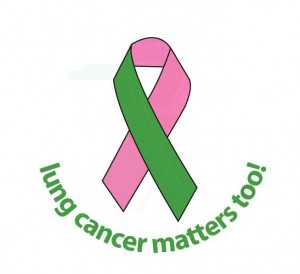Lung Cancer and Asbestos Exposure
Lung Cancer and Asbestos Exposure: What You Need to Know
Hello, NanaHood readers! This is Faith Franz from The Mesothelioma Center. Last year, Teresa let us share with you some information about mesothelioma and why the disease is relevant to women in the later stages of their lives. Today, she’s welcoming us back to pass along some similarly important information – this time, about lung cancer.
Lung cancer is the leading cause of cancer deaths in women. That’s surprising, considering the fact that it claims more lives than three female-specific cancers – breast cancer, uterine cancer and ovarian cancer – combined. And while many organizations (and Teresa!) promote much-needed awareness for these cancers, fewer organizations help people understand the real and significant dangers of asbestos-related lung cancer.
The American Lung Association expected to see 226,160 new cases of lung cancer last year. They knew that most of these cases would be the result of cigarettes, but asbestos – the same toxin that causes mesothelioma cancer – contributed to a number of those cases as well.
The Link between Asbestos and Lung Cancer
Lung cancer is one of the diseases that researchers have conclusively linked to asbestos exposure. Like mesothelioma, asbestos-related lung cancer develops after asbestos fibers are inhaled. In the case of mesothelioma, the fibers get trapped in the lining of the lungs rather than the lung tissue. Over time, these microscopic irritants can cause genetic changes that trigger cancerous developments.
As I mentioned in my last article for NanaHood, asbestos-related diseases have a long latency period. Many patients aren’t diagnosed until several decades after their last point of exposure. And for women, those exposures may have been few and sporadic.
Most exposure occurred in industrial occupations, where females traditionally made up a very small portion of the workforce. Some female-dominated occupations – like hairdressing and teaching – are associated with mild to moderate exposure risks, but many women were exposed in the home or environment. After 15 to 50 years after exposure and once the mesothelioma symptoms occur, the rates of survival are significantly low.
Links about this…
Many asbestos-related lung cancer cases have been traced to secondhand asbestos exposure. In these cases, women inhaled asbestos that their family members brought home on their clothing. In other cases, women lived in towns where asbestos was either mined, processed or manufactured into products, leading to increased amounts of asbestos contamination in the community.
It’s nearly impossible for doctors to differentiate between cigarette-induced lung cancer and asbestos-induced lung cancer. However, they do know that both factors can independently cause the disease – and that both factors together further increase a person’s risk. That means that smokers with a history of asbestos exposure have a higher lung cancer risk than asbestos-exposed never smokers.
Smokers can counteract some of that risk by quitting the habit. There are a number of organized support programs to facilitate this process. You can also register for routine health monitoring that can catch complications in their earliest stages – ensuring that you have the best possible shot at a healthy, happy future.
Author bio: Faith Franz has spent two years researching and writing for The Mesothelioma Center. As an advocate for alternative medicine, she encourages patients to explore all of the treatment options that could potentially save their life.
Links:
——
[1] http://www.facebook.com/themesocenter
[2] http://www.twitter.com/themesocenter
https://plus.google.com/u/0/b/109116131124897393971/109116131124897393971/posts
[4] http://www.asbestos.com/staff.php
This a blog hop….Thursday Thoughts Blog Hop….Grab our button and let us know what you are thinking about today!






Hi just wanted to give you a brief heads up and let you know a few of the pictures aren’t loading properly. I’m not sure why but I think its a linking issue.
I’ve tried it in two different browsers and both show the same results.
Yes, it is Theresa! All cancer is ugly!
I understand, Elena, I miss mine too. Mine died from colon cancer. All cancer is awful!!!!
Stopping smoking is hard but you feel better and smell better after you do!
thanks for commenting Rosey. You are so right, let’s hope they get screened!
Thank you for commenting Andres and thank you for your work!
Hi Jennifer, Thank you so much for commenting and I am so sorry about your mom. I lost mine in 1990 and still miss her terribly. Blessings to you and comfort.
Sincerely, Teresa
I am so glad to see this post. I lost my Mom less than two years ago to lung cancer. She was both a long time smoker (although she had been quit for almost 2 decades) plus she worked many years of her life in a textile mill. She only lived 19 days after her diagnosis. We barely had time to accept what was happening before it actually did. Mom had been sick for years and was not one to agree to preventative screening. She never had a mammogram in her life of 84 years of life. I learned a lot from her…one thing is how necessary it is to go to the doctor with suspicious symptoms.
Hi all,
My name is Andres RIobueno and I am a member of the Public Outreach Department at the Mesothelioma Center. Thanks for all your great comments!
Feel free to join the conversation on our facebook page at https://www.facebook.com/themesocenter.
It’s responsible for more deaths in women than Breast, Uterine, and Ovarian cancers combined. That’s pretty potent stuff. Definitely worth sharing. The more people know, the better they get at preventative screening and early detection, I’m sure.
thanks for hosting!! great information!!! i am hosting tomorrow and the link is up at http://www.frugalfitfamily.com – swing by and share if you can!
Thanks for the invite and for hosting!!!
New follower!
You should stop by Deezy Does It! (http://deezydoesiteezy.blogspot.com/) and join our weekly link ups with a giveaway that runs from Friday to Tuesday.
xx
Deezy
I quit smoking over ten years ago, it was the most difficult , but worthwhile thing I’ve ever done! Thanks for hosting!
Interesting information and also VERY frightening! I would have thought breast cancer was the leading cause of death in women. My nana passed away of lung cancer but she was a smoker unfortunately. I miss her every day!
Thanks for sharing the info. My father passed away from lung cancer. It’s a very ugly disease!
Thanks for hosting the hop.
Great info, thank you so much for putting it out there!
Holly
Not Done Growing